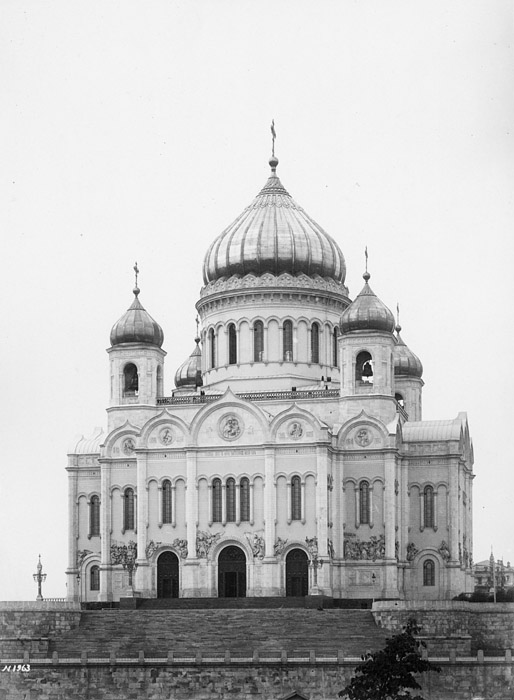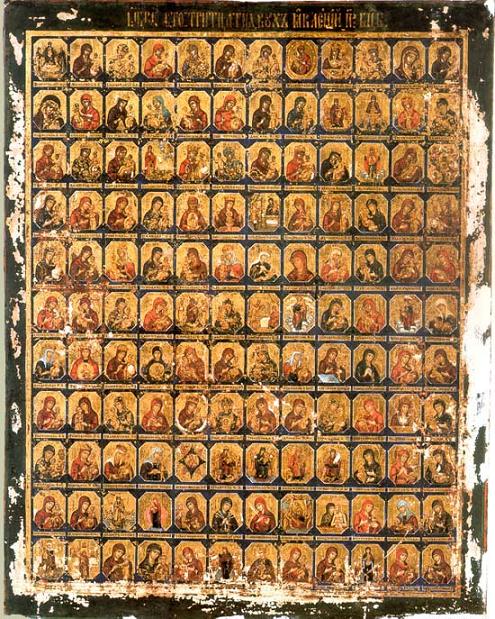|
Assumption Cathedral, Khabarovsk
The Dormition Cathedral of Khabarovsk (russian: Градо-Хабаровский Успенский собор, ''Grado-Khabarovsky Uspensky sobor'') is a Russian Orthodox cathedral. It is one of the largest churches in the Russian Far East, and was built in 2000–02 to a design by Yuri Podlesny, a local architect. The five-domed church stands about 60 meters tall. Its design harks back to Konstantin Thon's design for the Annunciation Church in Saint Petersburg. The church contains a 19th-century copy of the Abazino icon of the Theotokos from a previous church on the site. That church was built in the 1890s and contained the marble tomb of Baron Andrei von Korff. It was demolished by the Communists in 1930. See also * Khabarovsk Metropolitan Cathedral The Transfiguration Cathedral (russian: Спасо-Преображенский собор, ''Spaso-Preobrazhensky sobor'') on a steep bluff overlooking the Amur River in Khabarovsk stands 96 meters tall and is su ... [...More Info...] [...Related Items...] OR: [Wikipedia] [Google] [Baidu] |
Khabarovsk
Khabarovsk ( rus, Хабaровск, a=Хабаровск.ogg, r=Habárovsk, p=xɐˈbarəfsk) is the largest types of inhabited localities in Russia, city and the administrative centre of Khabarovsk Krai, Russia,Law #109 located from the China–Russia border, at the confluence of the Amur River, Amur and Ussuri Rivers, about north of Vladivostok. With a Russian Census (2010), 2010 population of 577,441 it is Russia's easternmost city with more than half a million inhabitants. The city was the administrative center of the Far Eastern Federal District of Russia from 2002 until December 2018, when Vladivostok took over that role. It is the largest city in the Russian Far East, having overtaken Vladivostok in 2015. It was known as ''Khabarovka'' until 1893. As is typical of the interior of the Russian Far East, Khabarovsk has an #Climate, extreme climate with very strong seasonal swings resulting in strong cold winters and relatively hot and humid summers. History Earliest record ... [...More Info...] [...Related Items...] OR: [Wikipedia] [Google] [Baidu] |
Russian Orthodox
Russian Orthodoxy (russian: Русское православие) is the body of several churches within the larger communion of Eastern Orthodox Christianity, whose liturgy is or was traditionally conducted in Church Slavonic language. Most Churches of the Russian Orthodox tradition are part of the Eastern Orthodox Church. Origin Historically, the term "Greek Orthodox" has been used to describe all Eastern Orthodox churches, since the term "Greek" can refer to the heritage of the Byzantine Empire. However, after the fall of Constantinople, the Greek influence decreased. Having lost its Christian '' basileus'' after the Turkish conquest, Constantinople, as a center of power, lost a significant part of its authority. On the other hand, the Moscow rulers soon began to consider themselves real ''Tsars'' (this title was already used by Ivan III), and therefore, according to them, the center of the Eastern Orthodox Church should be located in Moscow, and thus the bishop of Mosco ... [...More Info...] [...Related Items...] OR: [Wikipedia] [Google] [Baidu] |
Cathedral
A cathedral is a church that contains the '' cathedra'' () of a bishop, thus serving as the central church of a diocese, conference, or episcopate. Churches with the function of "cathedral" are usually specific to those Christian denominations with an episcopal hierarchy, such as the Catholic, Eastern Orthodox, Anglican, and some Lutheran churches.New Standard Encyclopedia, 1998 by Standard Educational Corporation, Chicago, Illinois; page B-262c Church buildings embodying the functions of a cathedral first appeared in Italy, Gaul, Spain, and North Africa in the 4th century, but cathedrals did not become universal within the Western Catholic Church until the 12th century, by which time they had developed architectural forms, institutional structures, and legal identities distinct from parish churches, monastic churches, and episcopal residences. The cathedral is more important in the hierarchy than the church because it is from the cathedral that the bishop governs the area unde ... [...More Info...] [...Related Items...] OR: [Wikipedia] [Google] [Baidu] |
Church (building)
A church, church building or church house is a building used for Christian worship services and other Christian religious activities. The earliest identified Christian church is a house church founded between 233 and 256. From the 11th through the 14th centuries, there was a wave of church construction in Western Europe. Sometimes, the word ''church'' is used by analogy for the buildings of other religions. ''Church'' is also used to describe the Christian religious community as a whole, or a body or an assembly of Christian believers around the world. In traditional Christian architecture, the plan view of a church often forms a Christian cross; the center aisle and seating representing the vertical beam with the Church architecture#Characteristics of the early Christian church building, bema and altar forming the horizontal. Towers or domes may inspire contemplation of the heavens. Modern churches have a variety of architectural styles and layouts. Some buildings designe ... [...More Info...] [...Related Items...] OR: [Wikipedia] [Google] [Baidu] |
Russian Far East
The Russian Far East (russian: Дальний Восток России, r=Dal'niy Vostok Rossii, p=ˈdalʲnʲɪj vɐˈstok rɐˈsʲiɪ) is a region in Northeast Asia. It is the easternmost part of Russia and the Asian continent; and is administered as part of the Far Eastern Federal District, which is located between Lake Baikal in eastern Siberia and the Pacific Ocean. The area's largest city is Khabarovsk, followed by Vladivostok. The region shares land borders with the countries of Mongolia, China, and North Korea to its south, as well as maritime boundaries with Japan to its southeast, and with the United States along the Bering Strait to its northeast. The Russian Far East is often considered as a part of Siberia (previously during the Soviet era when it was called the Soviet Far East). Terminology In Russia, the region is usually referred to as just "Far East" (). What is known in English as the Far East is usually referred to as "the Asia-Pacific Region" (, abbrevia ... [...More Info...] [...Related Items...] OR: [Wikipedia] [Google] [Baidu] |
Konstantin Thon
Konstantin Andreyevich Thon, also spelled Ton (russian: Константи́н Андре́евич Тон; October 26, 1794 – January 25, 1881) was an official architect of Imperial Russia during the reign of Nicholas I. His major works include the Cathedral of Christ the Saviour, the Grand Kremlin Palace and the Kremlin Armoury in Moscow. Early life Konstantin, born in St. Petersburg to the family of a German jeweller, was one of three Thon brothers who all rose to become notable architects. He studied at the Imperial Academy of Arts (1803–15) under the Empire Style architect Andrey Voronikhin, best remembered for his work on the Kazan Cathedral, situated right in the middle of the Nevsky Prospekt. He studied Italian art in Rome from 1819 to 1828, and on his return home was admitted to the academy as its member (1830) and professor (1833). In 1854, he was appointed rector of the architectural division of the academy. Thon first attracted public attention with his sumpt ... [...More Info...] [...Related Items...] OR: [Wikipedia] [Google] [Baidu] |
Saint Petersburg
Saint Petersburg ( rus, links=no, Санкт-Петербург, a=Ru-Sankt Peterburg Leningrad Petrograd Piter.ogg, r=Sankt-Peterburg, p=ˈsankt pʲɪtʲɪrˈburk), formerly known as Petrograd (1914–1924) and later Leningrad (1924–1991), is the second-largest city in Russia. It is situated on the Neva River, at the head of the Gulf of Finland on the Baltic Sea, with a population of roughly 5.4 million residents. Saint Petersburg is the fourth-most populous city in Europe after Istanbul, Moscow and London, the most populous city on the Baltic Sea, and the world's northernmost city of more than 1 million residents. As Russia's Imperial capital, and a historically strategic port, it is governed as a federal city. The city was founded by Tsar Peter the Great on 27 May 1703 on the site of a captured Swedish fortress, and was named after apostle Saint Peter. In Russia, Saint Petersburg is historically and culturally associated with t ... [...More Info...] [...Related Items...] OR: [Wikipedia] [Google] [Baidu] |
Theotokos Of Abazino
''Theotokos'' ( Greek: ) is a title of Mary, mother of Jesus, used especially in Eastern Christianity. The usual Latin translations are ''Dei Genitrix'' or ''Deipara'' (approximately "parent (fem.) of God"). Familiar English translations are "Mother of God" or "God-bearer" – but these both have different literal equivalents in Greek, Μήτηρ Θεοῦ and Θεοφόρος ("Who gave birth to one who was God", "Whose child was God", respectively). The title has been in use since the 3rd century, in the Syriac tradition (as ) in the Liturgy of Mari and Addai (3rd century)''Addai and Mari, Liturgy of''. Cross, F. L., ed. ''The Oxford Dictionary of the Christian Church''. Oxford University Press. 2005. and the Liturgy of St James (4th century). The Council of Ephesus in AD 431 decreed that Mary is the ''Theotokos'' because Her Son Jesus is both God and man: one divine person from two natures (divine and human) intimately and hypostatically united. The title of Mother ... [...More Info...] [...Related Items...] OR: [Wikipedia] [Google] [Baidu] |
Theotokos
''Theotokos'' (Greek: ) is a title of Mary, mother of Jesus, used especially in Eastern Christianity. The usual Latin translations are ''Dei Genitrix'' or ''Deipara'' (approximately "parent (fem.) of God"). Familiar English translations are "Mother of God" or "God-bearer" – but these both have different literal equivalents in Greek, Μήτηρ Θεοῦ and Θεοφόρος ("Who gave birth to one who was God", "Whose child was God", respectively). The title has been in use since the 3rd century, in the Syriac tradition (as ) in the Liturgy of Mari and Addai (3rd century)''Addai and Mari, Liturgy of''. Cross, F. L., ed. ''The Oxford Dictionary of the Christian Church''. Oxford University Press. 2005. and the Liturgy of St James (4th century). The Council of Ephesus in AD 431 decreed that Mary is the ''Theotokos'' because Her Son Jesus is both God and man: one divine person from two natures (divine and human) intimately and hypostatically united. The title of Mother o ... [...More Info...] [...Related Items...] OR: [Wikipedia] [Google] [Baidu] |
Andrei Von Korff
Baron Andrey Nikolayevich Korf or Korff (russian: Андрей Николаевич Корф; 1831–1893) was the first Viceroy (Governor General) of the Russian Far East (1884–93). The names of the village of Korf and the Korfa Bay commemorate him. He came from the Korff noble family. He was an Imperial Russian baron of Baltic German descent and an infantry general of the Imperial Russian Army. Andrey Korff took part in the Caucasian War and led an attack on Veden in 1859. He initiated the establishment of the Officers Infantry School. In 1884, Korf was put in charge of the newly established Maritime Governorate-General, which included the Russian Far East from the island of Sakhalin in the east to Lake Baikal in the west. Korff undertook some measures that facilitated further development of the region. He worked to improve education, to encourage colonization of the Ussuri River basin, to protect the sealskin trade, to create commercial relations with Japan and China, ... [...More Info...] [...Related Items...] OR: [Wikipedia] [Google] [Baidu] |
Khabarovsk Metropolitan Cathedral
The Transfiguration Cathedral (russian: Спасо-Преображенский собор, ''Spaso-Preobrazhensky sobor'') on a steep bluff overlooking the Amur River in Khabarovsk stands 96 meters tall and is supposed to be the third tallest church in Russia after St. Isaac's Cathedral and the Cathedral of Christ the Saviour. It was built over 2001-2004 to a traditional design reminiscent of Konstantin Thon's works. The church is surmounted by four Ukrainian-style gilded domes, the central one being the largest. Its spectacular location on a hill was chosen by Patriarch of Moscow and all Rus' Alexis II of Moscow during a helicopter flight over Khabarovsk. References See also * Khabarovsk City Cathedral The Dormition Cathedral of Khabarovsk (russian: Градо-Хабаровский Успенский собор, ''Grado-Khabarovsky Uspensky sobor'') is a Russian Orthodox cathedral. It is one of the largest churches in the Russian Far East, an ... * List of tall ... [...More Info...] [...Related Items...] OR: [Wikipedia] [Google] [Baidu] |








